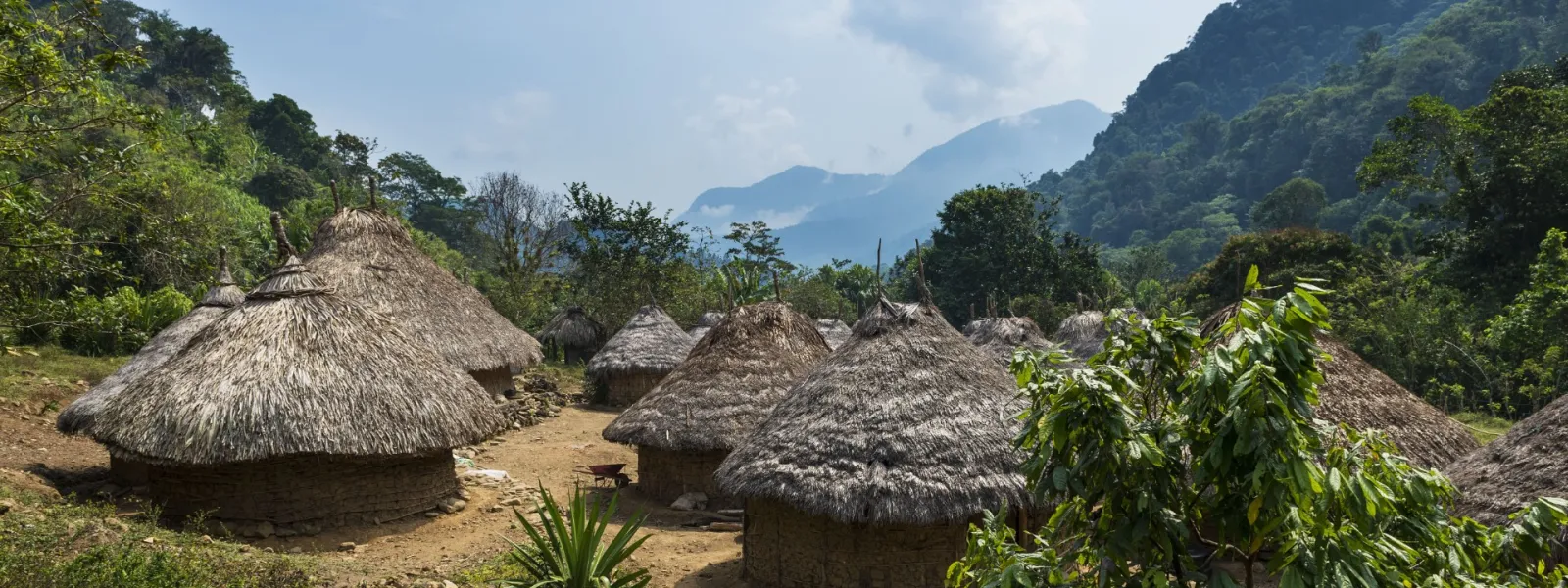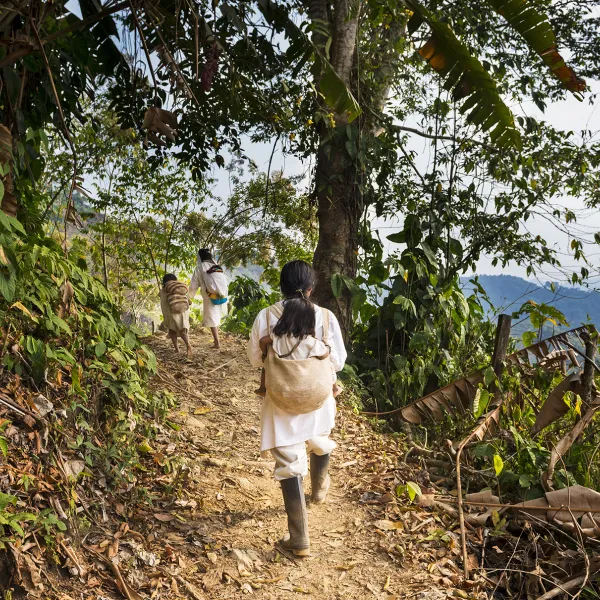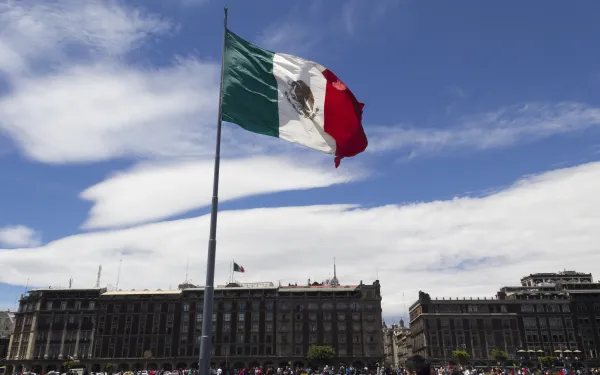
Project
Preserving the legacy of the Sierra Nevada de Santa Marta, Heart of the World
Rising abruptly from Colombia’s Caribbean coast, the Sierra Nevada de Santa Marta reaches 5,775 meters (18,946 ft.) at its highest points, the peaks of Bolívar and Colón. It is the highest coastal mountain system in the world, a place where indigenous knowledge and nature’s own wisdom converge.
The sheer changes in elevation create a wide variety of ecosystems within a small area, where the diversity of plant and animal life creates a unique exuberant region. The melting snows of the highest peaks form rivers and lakes, whose freshwater flows down steep slopes to the tropical sea at the base of the mountains.
The indigenous Arhuaco, Kogi, Wiwa, and Kankuamo people protect and care for this natural treasure with an authority they have inherited from their ancestors. According to their worldview the land is sacred and shared in divine communion between humans, animals, plants, rivers, mountains, and the spirts of their ancestors.
Despite this ancestral inheritance, development projects proposed for the region have failed to take the opinions of these indigenous groups into consideration. The Sierra Nevada de Santa Marta is currently threatened by 251 mineral concessions, hydroelectric projects, agriculture, urban sprawl, and infrastructure projects.
Many of these concessions were granted without the prior consultation of the indigenous communities, which represents a persistent and systematic violation of their rights.
Mining, which implies the contamination and erosion of watersheds, threatens the health of more than 30 rivers that flow out of the Sierra; these are the water sources of the departments of Magdalena, César, and La Guajira.
These threats have brought this natural paradise to the brink of no return. With it, would go the traditional lives of its indigenous inhabitants, who are dependent on the health of their land and the sacred sites it contains.
The Sierra hosts the archaeological site of la Ciudad Perdida, the Lost City, known as Teyuna, the cradle of Tayrona civilization. According to tradition, it is the source from which all nature was born—the living heart of the world.
The four guardian cultures of the Sierra are uninterested in allowing this natural and cultural legacy to disappear.

Related projects
Civil society groups go to Court to defend Panama Bay
Groups submit arguments supporting government’s case for maintaining wildlife refuge. Panama City, Panama — Today, on International Mangrove Day, two civil society organizations announce their legal support for the government of Panama in a lawsuit brought by developers challenging the protected status of Panama Bay. The groups, the Interamerican Association for Environmental Defense (AIDA) and the Centro de Incidencia Ambiental (CIAM), submitted legal briefs detailing national and international legal arguments for upholding environmental protections established by the government in 2009 through a resolution issued by the environmental authority in Panama. The developers who are contesting the law, Panama Bay Development and Compañia Lefevre, are seeking to open the area to development of vast tourism complexes. Extensive tourism in the area would bring devastating environmental impacts to the sensitive ecosystem. The Panama Bay coastline is ringed with miles of pristine mangroves, which provide critical breeding ground for species relied upon by Panama’s fishing industry. Each kilometer of mangrove-covered coastline generates about $100,000 USD for Panama annually. Mangroves also help protect Panama from the effects of global climate change by buffering the coast from increasingly powerful tropical storms and by storing carbon from the atmosphere in their roots. A mangrove forest can sequester 50 times more carbon than a tropical forest of the same size, making mangroves a conservation priority if countries wish to halt catastrophic climate change. The protected area of Panama Bay is roughly 211,000 acres, slightly larger than the land area of New York City. Panama Bay is one of the earth’s most biodiverse places and is an essential habitat for migratory birds and threatened species such as jaguars and loggerhead turtles. “In the face of ever more powerful and dangerous climate-change-driven tropical storms, destroying coastal mangroves is one of the worst things a country like Panama could do,” said Anna Cederstav, Ph.D., staff scientist and co-director of AIDA. According to Sandra Moguel, an attorney for AIDA in Mexico, “Article four of the Constitution of Panama requires the observance of the rules of international law throughout the territory of that country. Obligations under the Ramsar Convention on Wetlands of International Importance and the Convention on Biological Diversity, both of which have been ratified by Panama, should thus be taken into consideration in deciding the challenge against the natural protected area.” "The creation or declaration of a protected area does not constitute expropriation. What it does is protect and guarantee the right to a healthy environment contained in the Panamanian Constitution” said Maria Acuña, CIAM´s legal advisor.
Read more
Mexican Constitution protects human rights
On June 9, 2011, Mexico rewrote history. The Mexican Congress approved revisions that expressly recognize human rights in the national constitution for the first time. The new language requires all authorities to adhere to international human rights treaties Mexico is a signatory to when those treaties are more expansive than the "individual guarantees" currently on the books. As modified, Article 1 of the constitution now recognizes human rights in general and incorporates international law. This means groups such as AIDA and communities in Mexico will have better legal tools for defending the right to a healthy environment or clean drinking water. Or, for example, because indigenous communities’ right to free, prior, and informed consent is granted in international law, Mexico will now have to recognize this right. Moreover, although the Mexican constitution already recognized some rights, enforcement has been difficult. The revision provides additional legal tools and thus raises hopes for enhanced protection of those rights. These constitutional changes came after a four-year process initiated by the UN Office of the High Commissioner for Human Rights in Mexico, and involving academics, nongovernmental organization, and independent experts. AIDA contributed by evaluating existing legal tools for protecting human rights as well as international legal obligations. In 2008, the Mexican Congress started considering the human-rights-related constitutional revision, which was finally partially approved in June, 2011. While the Mexican Congress and government should be applauded for its vision, the constitutional change’s effectiveness remains to be seen. Recognizing human rights is only the first step, and the new commitment will mean little without compliance. In coordination with our allies in the country, AIDA will monitor Mexican cases to ensure enforcement of this profound advancement and improved protection of the right to a healthy environment.
Read more
Resort endangers Mexican mangroves and wetlands
A proposed resort three times the size of Cancun is bad news for Mexico’s fragile coastal mangrove ecosystems. Costa del Pacifico (CIP), a mega-resort that the Mexican government is planning to build near Mazatlan, is expected to attract three million visitors by the year 2025. If this project proceeds as planned, it will imperil nearby wetlands that safeguard Mexico’s last remaining mangrove forests and 60 endangered species. AIDA is working to protect these treasured ecosystems. There is still hope for the mangroves because Mexican authorities specified in May 2011 that CIP will be built in stages that require completion of environmental studies and permits. In June 2009, we submitted a petition to the Secretariat of the Ramsar Convention (SRC), an international treaty aimed at wetlands conservation. In this petition, AIDA and five co-signing environmental organizations called upon the SRC to encourage and support the Mexican government in conducting a comprehensive environmental review of the CIP project, as required by national and international laws. The proposed CIP resort is located at the edge of Marismas Nacionales and in close proximity to Laguna Huizache-Caimanero, both of which are classified as “wetlands of international importance". These biopersity hot spots support an astonishing array of wetlands wildlife including birds, fishes, mammals, reptiles and plants. Many are already threatened or endangered, such as the puma, jaguar, river otter, collared peccary, white-tailed deer, American Crocodile, Boa constrictor and Mexican Beaded Lizard. To provide water and electricity to resort guests, the Mexican government proposes building a hydroelectric dam in the San Pedro River. This dam would sharply reduce water flow to the Marismas wetlands, directly harming plant and animal populations and disrupting movement and migration patterns critical to many species’ survival. The government also plans to pert substantial amounts of water from the Presidio River for irrigation, an action likely to harm the Laguna Huizache-Caimanero wetlands as well. As with most golf courses, substantial amounts of chemical pesticides and fertilizers will likely be applied to the resort’s four courses and extensive landscaping. Toxic runoff from these areas would contaminate the wetlands, potentially poisoning many animal species and causing algae blooms that create oxygen-starved dead zones. All these different impacts combined would likely cause extensive damage to the forest of mangrove trees that dominate the wetlands. Mangroves are barrier ecosystems that shelter coastlines from the damaging impact of storms. Mangrove ecosystems are also thriving nurseries for breeding fish and migratory birds. Marismas Nacionales, for example, harbors more than 100 species of migratory birds. In addition, mangroves act as powerful carbon sinks that help buffer the effects of climate change. The trees actively remove excess carbon dioxide (CO2) in the atmosphere (up to 50 times more efficiently than tropical rainforests), and the peat sediment that nurtures the trees acts as a reservoir for large quantities of CO2. Consequently, when mangroves are destroyed, we lose both their ability to absorb excess CO2 and we introduce new carbon dioxide that was previously locked up in the sediment. At AIDA’s request, a SRC technical mission toured the area in June 2010 to gather information. The following August the SRC mission issued a report which recommended that the government carry out a strategic environmental evaluation to determine the cumulative effects of multiple mega-projects on these wetlands, take account of the multiple environmental goods and services provided by these wetlands, and document the inter-connected nature of the Huizache Caimanero-Marismas Nacionales ecosystems. The report further recommended that the relevant water, fishing, and environmental protection authorities be incorporated into the National Committee for Wetlands. The SRC mission noted that massive tourist developments should not be constructed in Ramsar protected wetlands, given the importance of these areas for Mexico and the international community. It also recommended that the Marismas Nacionales and Huizache Caimanero wetlands be added to the Register of Montreux, which contains a list of all Ramsar wetland sites that are gravely threatened. This is an important example of how civil society participation can help in the conservation of protected wetlands. AIDA will continue to play a role in the protection of Mexican wetlands by urging full compliance with the Ramsar Mission's recommendations.
Read more